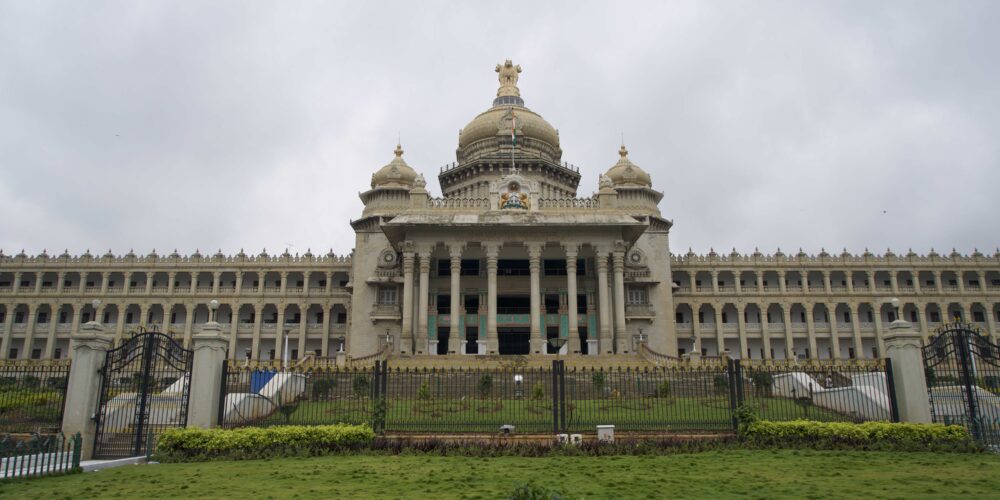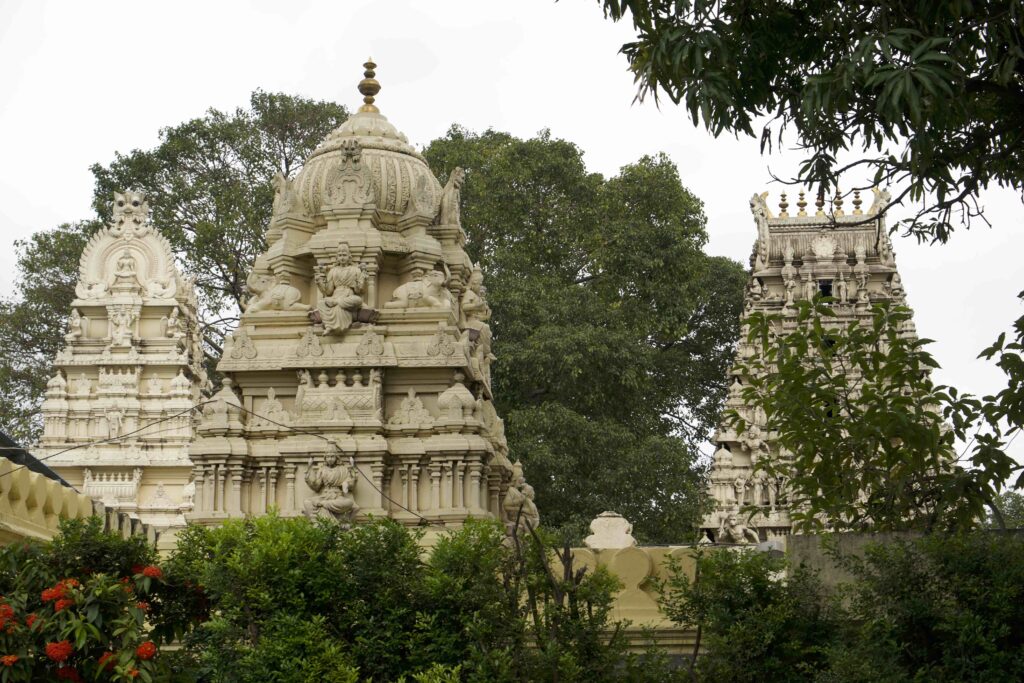
Let this be your Bengaluru Travel Guide. There are so many temples, gardens and savory delights, if you go, we have one piece of advice for you; get a guide.
Formerly known as Bangalore, the capital city of the state of Karnataka was once known as India’s garden city. It was also known as the pub city as this is the home of Kingfisher beer and at one time there were about 600 pubs. At 1000 metres above sea level this was where the British came to stay cool and where Indians came to retire. For the longest time about one million peaceful souls lived serenely under its graceful canopy of green.
Now, Bengaluru is India’s silicon city (only rivalled by Hyderabad). And, it has an estimated 13 times the population with an average age between 22 to 40. The city has spread like an internet virus. We found the expert knowledge of a local guide in getting around town immensely helpful.
The lay of the land
The Bengaluru airport is new and surrounded by I.T. business campuses. When we visited there were about 130 technology institutes. The city has removed roughly 35 per cent of its sun umbrella of trees to make way for roads and a new Light Rail Transit (LRT) system. Meanwhile, as everyone literally waits for the train, older parts of the city are often crippled with traffic.
Despite the disruption, Bengaluru is still very green. Mature trees lines almost every street and there are plenty of parks where locals sit to soak up the trees’ gifts of oxygen and shade. There’s an enjoyable climate year round here due to the city’s elevation. While there aren’t a lot of monuments compared to other Indian cities, the ones that are here are charming. This post shares a few of our favourites along with some delectable finds for food lovers.
Bengaluru Travel Guide – things to see
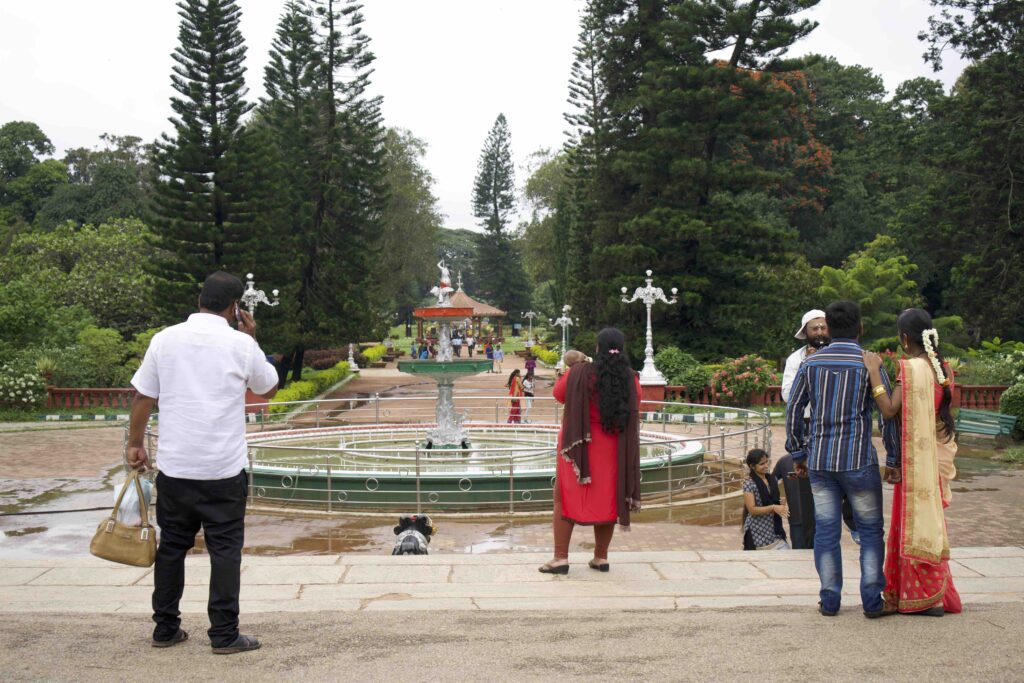
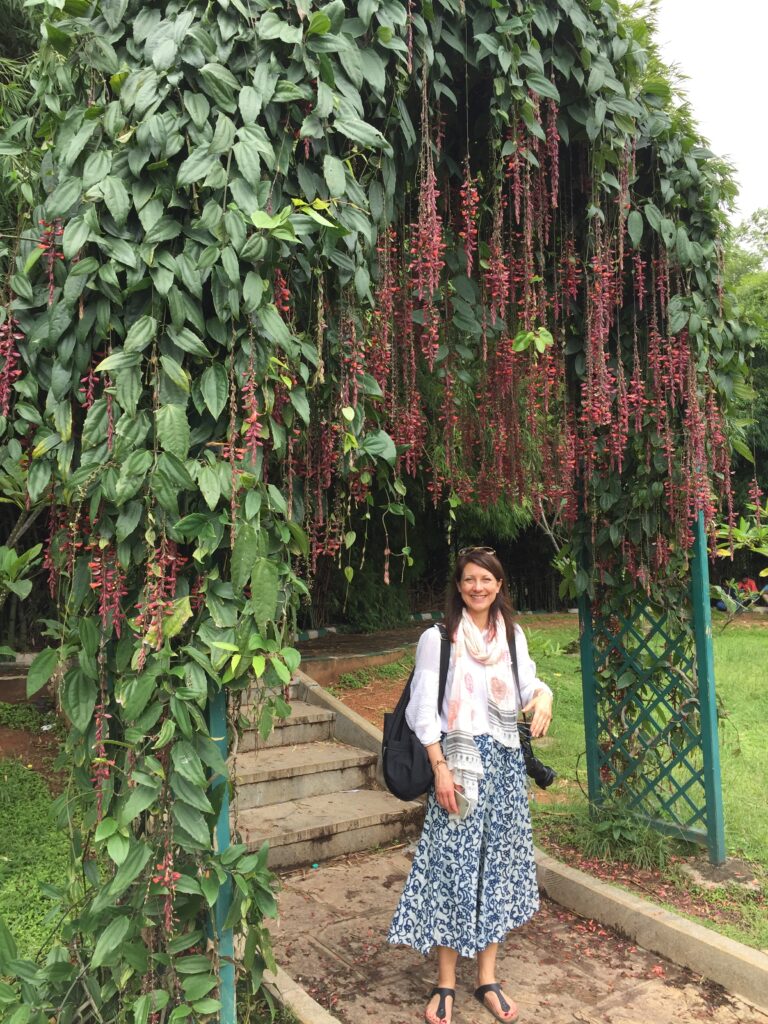
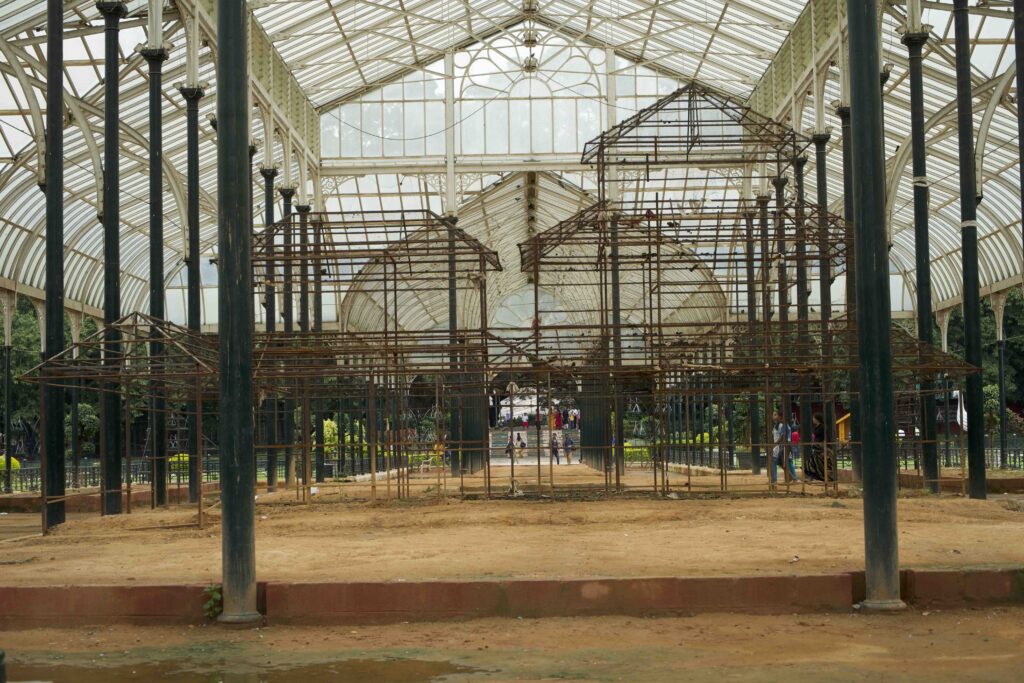
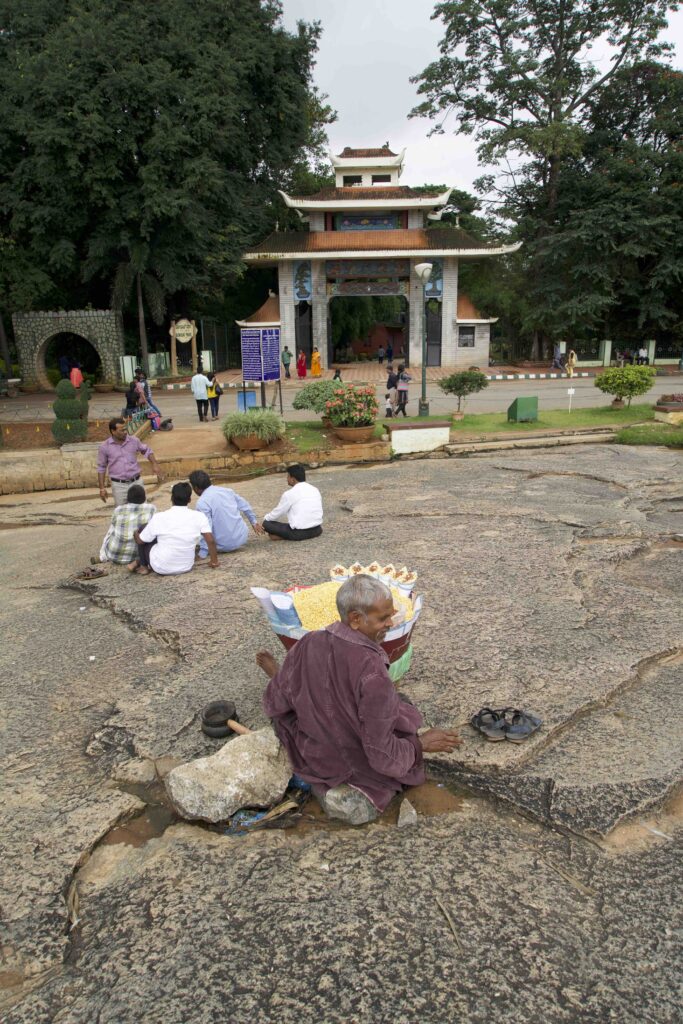
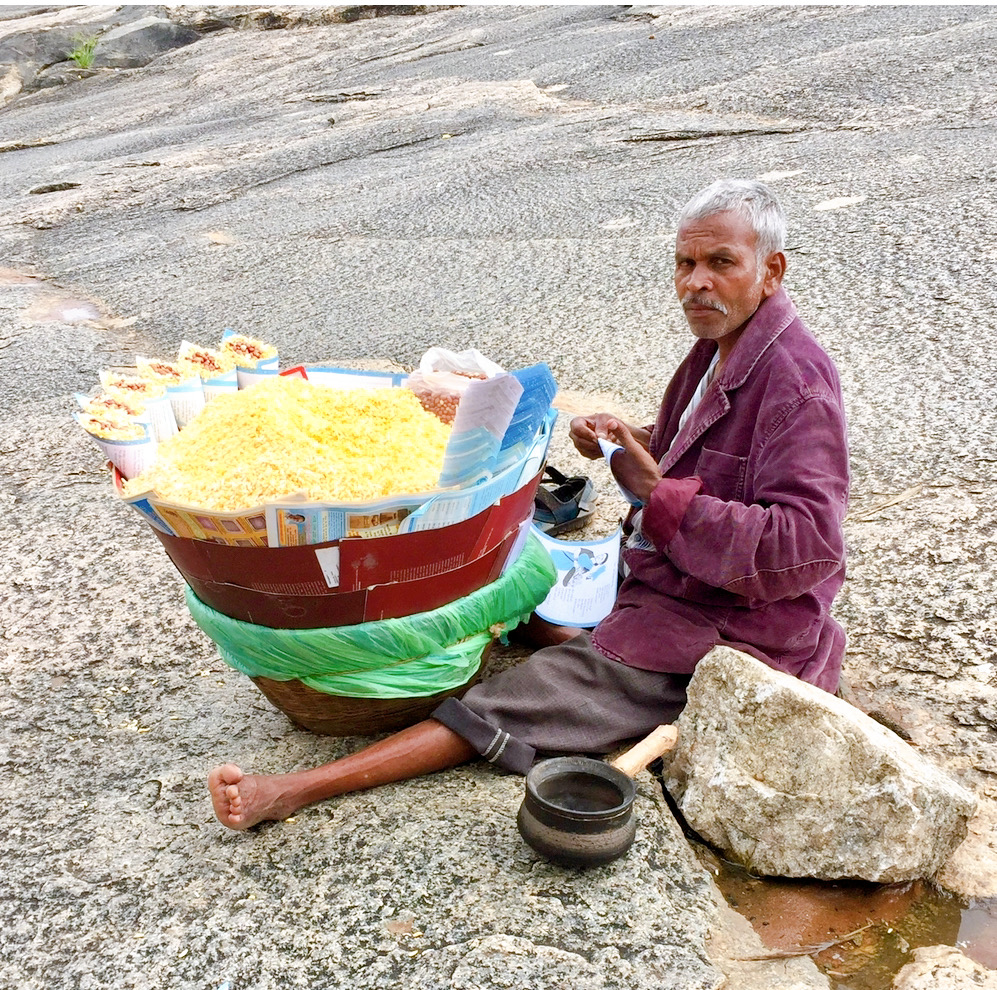
Lalbagh Botanical Gardens
Visit the Lalbagh Botanical Gardens and enjoy a leisurely stroll through a small part of its 240 acres. There are 1000 species of flora on display. Labels adorn each tree. As you might expect, given the climate, they are all quite exotic. Several Indian dignitaries and British royals have visited.
We walked to Lalbagh Rock, a big red rock in the center of the gardens. It’s estimated to be at least 3,000 million years old. You can easily climb the worn red rock for a panoramic view of the city. We did. And, back at the bottom our reward was the chance to buy freshly roasted peanuts with chili and lime. From here we traversed the city to our first temple visit in Bengaluru.
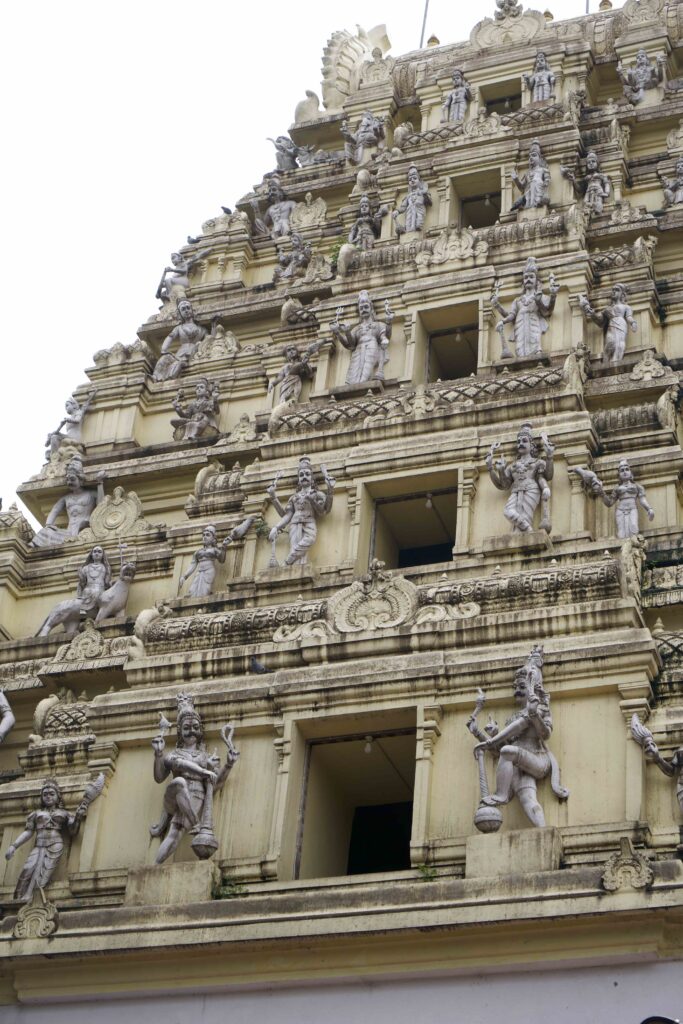
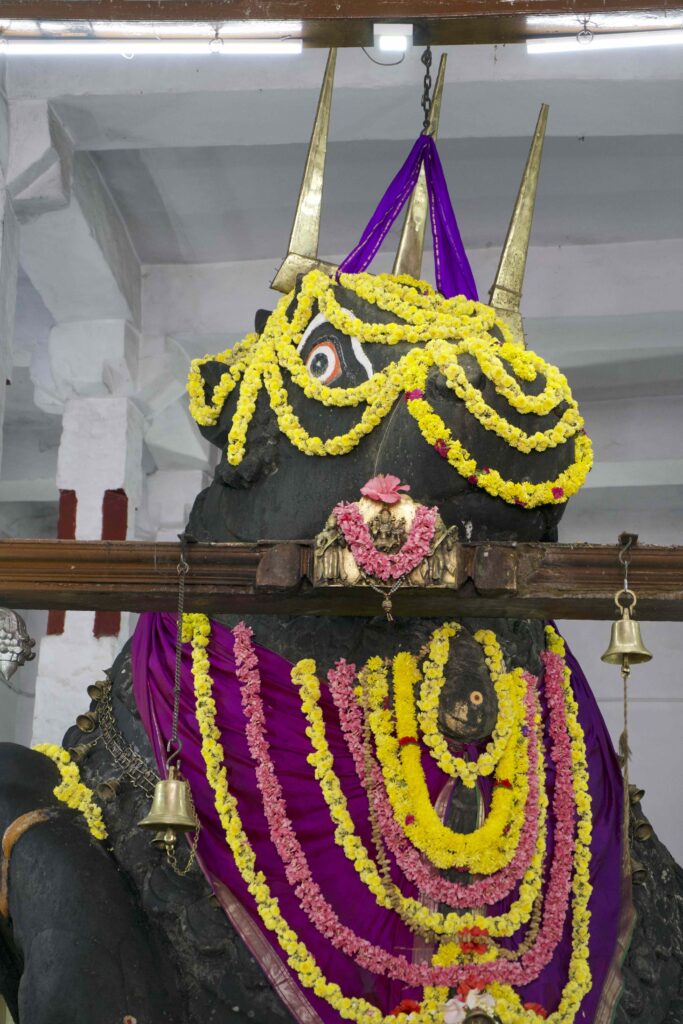
Sri Big Bull Temple
Sri Big Bull Temple in the NR Colony district is a protected monument since 1961. Legend has it that a bull in the area repeatedly destroyed the ground nut (peanut) crop. The farmers built the shrine to Shiva’s transport, Nandi the bull, to appease the bull God. After they were done, the local bull pest stopped disturbing the crops. And, a groundnut festival called Kadalekai Parase, is held annually in November or December ever since.
The Nandi statue here is a monolith. And, at 4.6 metres in height and 6.1 metres in length it is one of the largest Nandi statues in the world. The Temple around it was built in 1537 by Kempe Gowda, the founder of Bengaluru. It is quiet here and again we were struck by the pleasant temperatures of the city. Next, we went to another of the city’s hidden treasures located in South Bangalore.
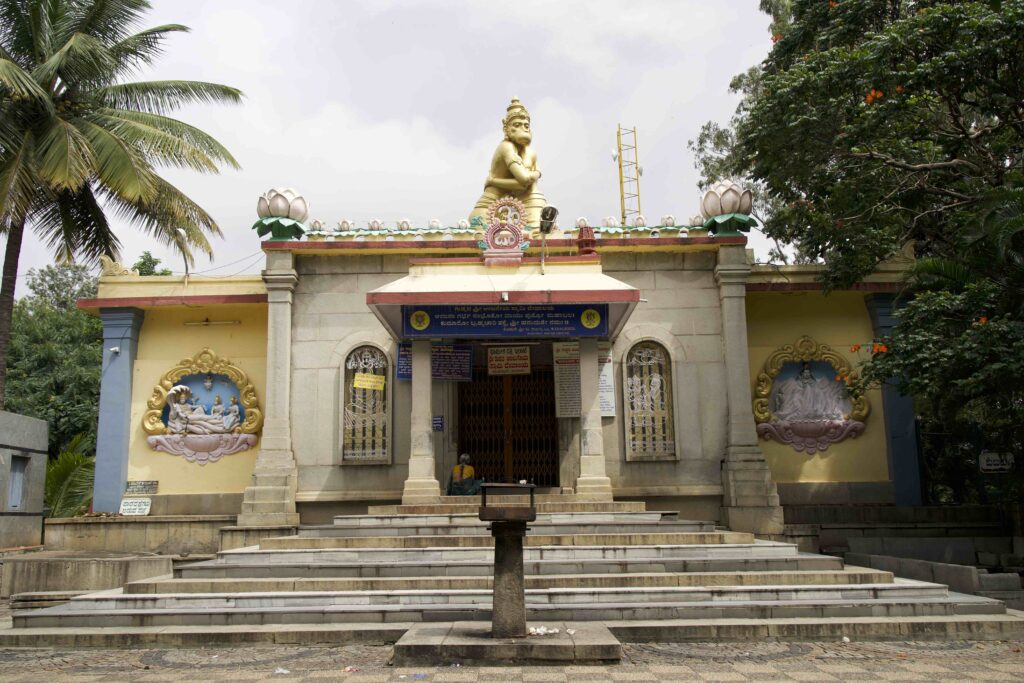
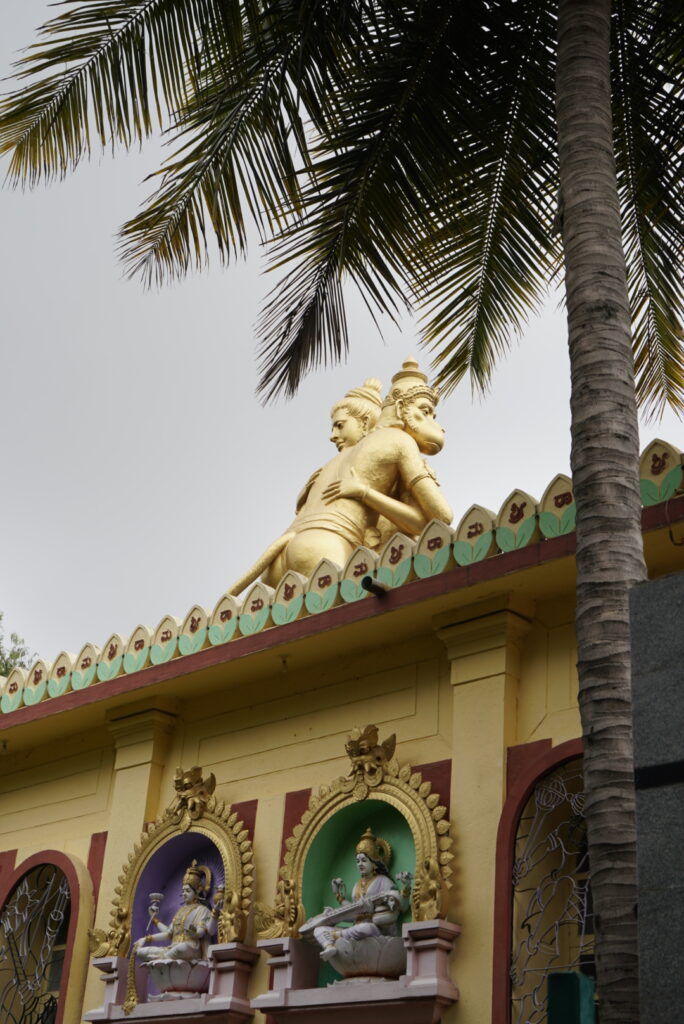
Sri Ramanjaneya Temple Hanumanthana Gudda
There are at least seven Hanuman Temples in Bengaluru and this one is another space to escape crowds and create the mental space for contemplation. Plus, it is very sweet. A nine meter tall golden statue of Hanuman hugging Lord Rama sits atop the temple. It is a symbol of the love and devotion they shared after the defeat of the evil ruler Ravana in Sri Lanka.
About that guide…
Both the Hanuman and the Sri Big Bull sites are tucked away and not easily found. That is why in Bengaluru you will really benefit from hiring a guide and driver with local knowledge. They’ll get you through the maze that is the old city. And, they can showcase the best suburb neighbourhoods or in local vernacular, “extensions.” It took us a while to realize extensions equaled the western term of suburbs. But, the word definitely works.
A good local driver is especially important because a whopping seven million of Bangalore’s 13 million residents own cars. That’s a lot of cars. The predominantly young population (the average age is between 22 to 40) has an unprecedented amount of disposable income. They can afford cars. And, as mostly young professionals working long hours, it’s not surprising to learn that two-thirds of Bangaloreans eat out three meals a day, every day.
Bengaluru Travel Guide – things to eat
In the spirit of “when in Rome,” we decided to hit some locals’ favourites to learn where and what Bangaloreans eat. Since, allegedly, so few people cook at home here, this was our bond with the local food scene.
Everywhere we went, we chatted up the people we met and they all said the same thing. “You must have the local food. There are so many delicacies. It’s the best in South India.”
Turns out, dosas are the most beloved of foods here. And, when people took us out for a meal it was dosas – and nothing but – that they wanted us to eat. That said, the dosas here are fluffier, thicker, and crispier. Our time was limited in the garden city so here are the few fun things we were able to see and eat.
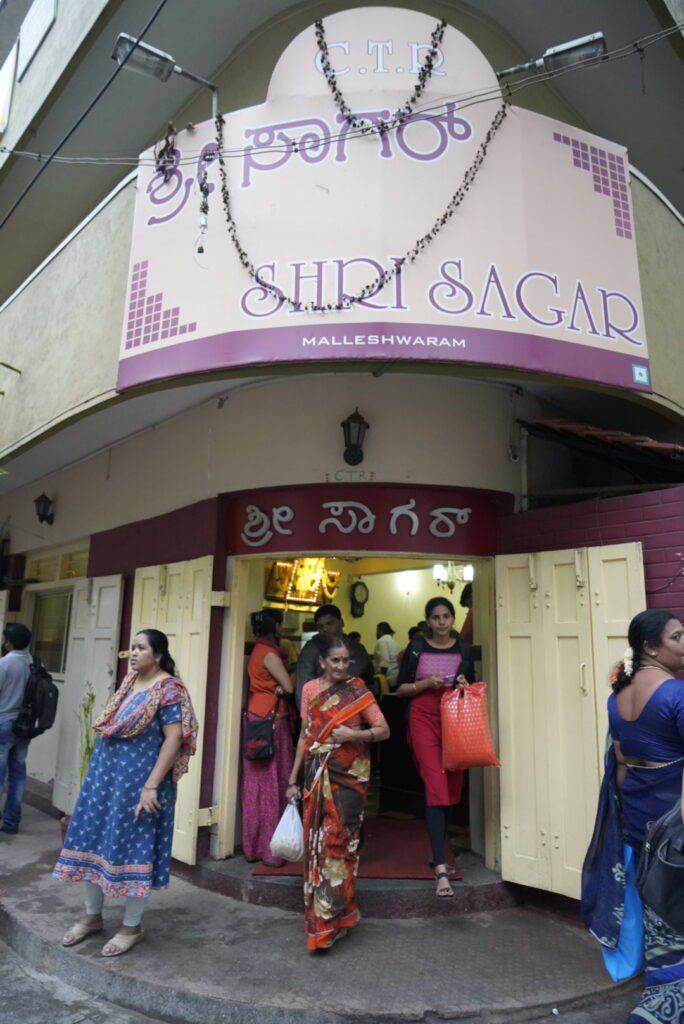
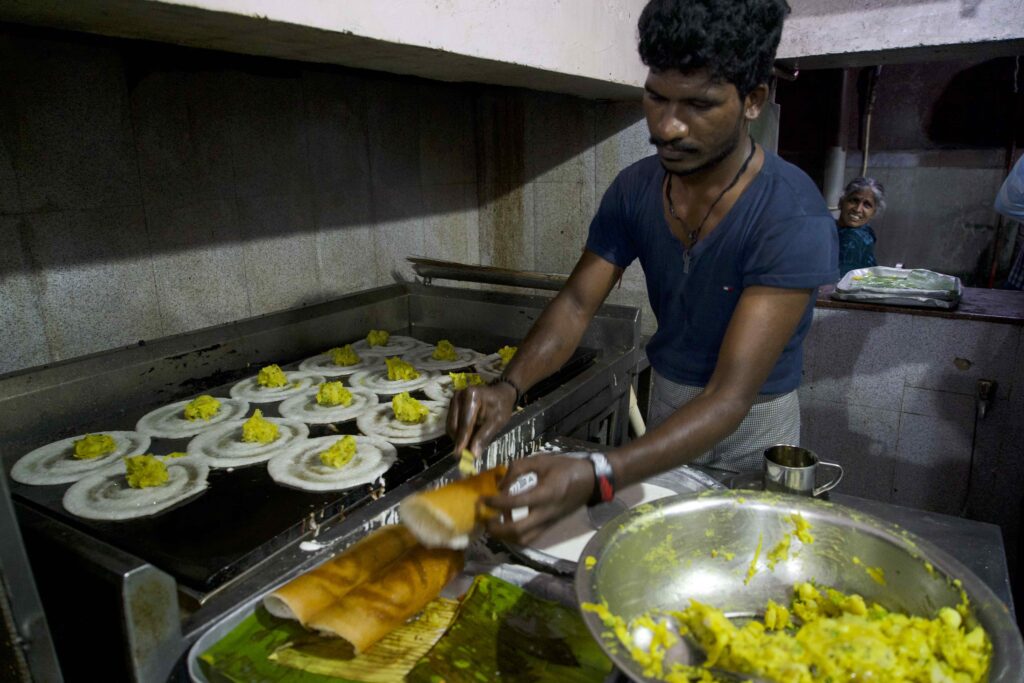
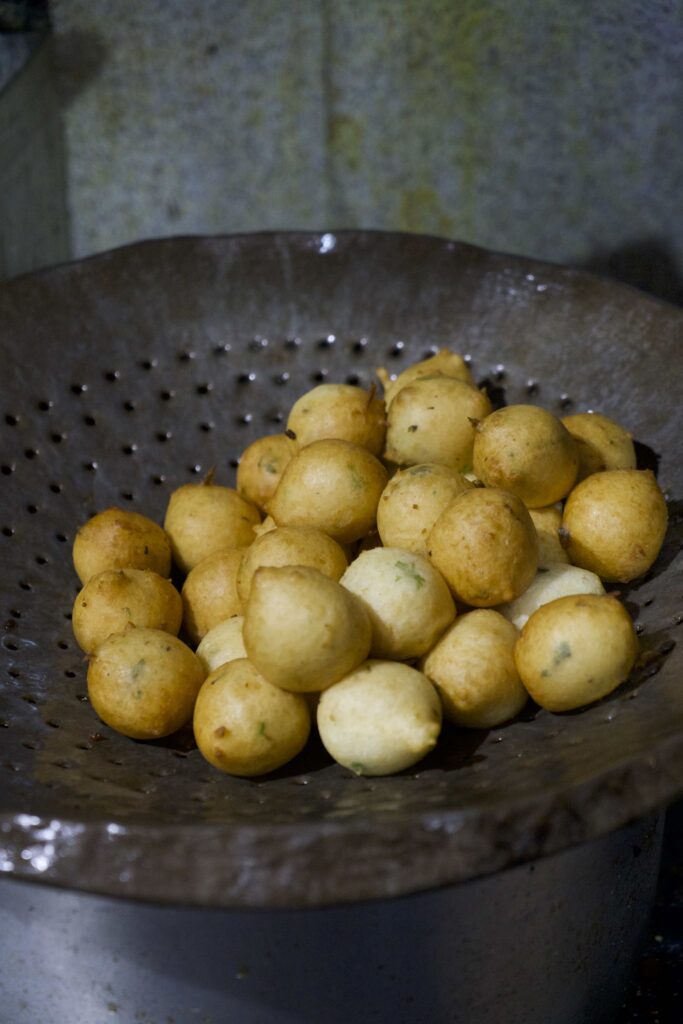
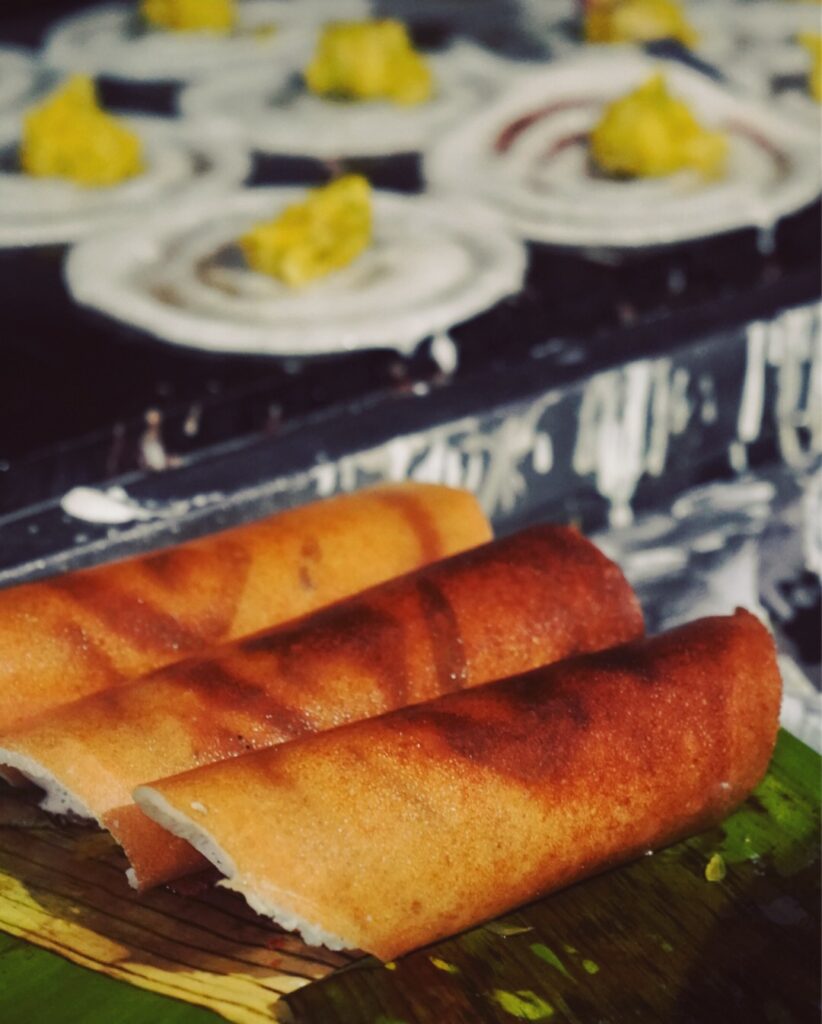
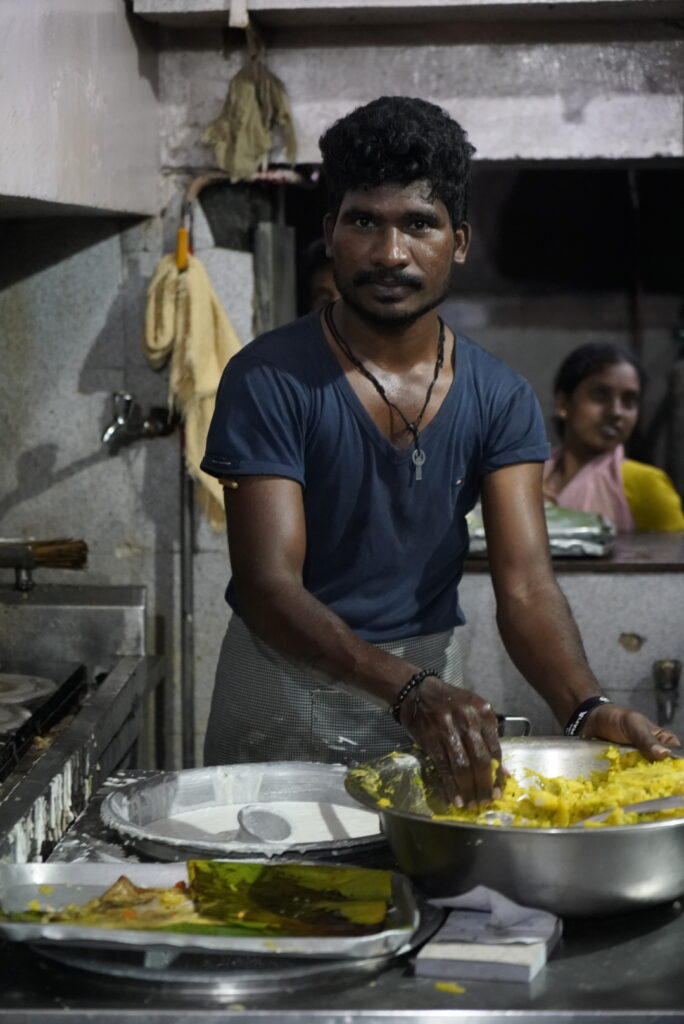
Shri Sagar Malleshwaramand
Visit Shri Sagar Malleshwaramand, a central and very famous dosa place. It will be packed. There may even be a line up down the block. When you make it to the front door, the manager will greet you and guide you to a table. Once in, we were left to hover over other guests who looked like they were nearly done with their meal. At first, we were concerned that they were being unduly rushed because we were the only foreigners in the place. But then we relaxed because it was just the owner’s way of getting people off the busy street where the line up was getting longer by the minute.
When we got to sit, it was worth the cramped quarters as fluffy fritters and steaming hot dosas landed in front of us almost as quickly as our bottoms hit the chairs. With barely room to squeeze our hands up to our plates we savoured every morsel of both the bhajias and dosas as we dipped them in flavourful chutneys. The fritters, we learned, are called Bangalore Bhajia. We’ll share that recipe in another post.
Declaring our delight in the taste and texture of the bhajias earned us a tour of the kitchens. The team here work like a well-oiled cooking machine. They pump out a never ending supply of the house favourites. We left damp with sweat and filled with admiration for how they kept their cool in such a furnace. Later in the day, there was another chance to mingle and eat with locals.
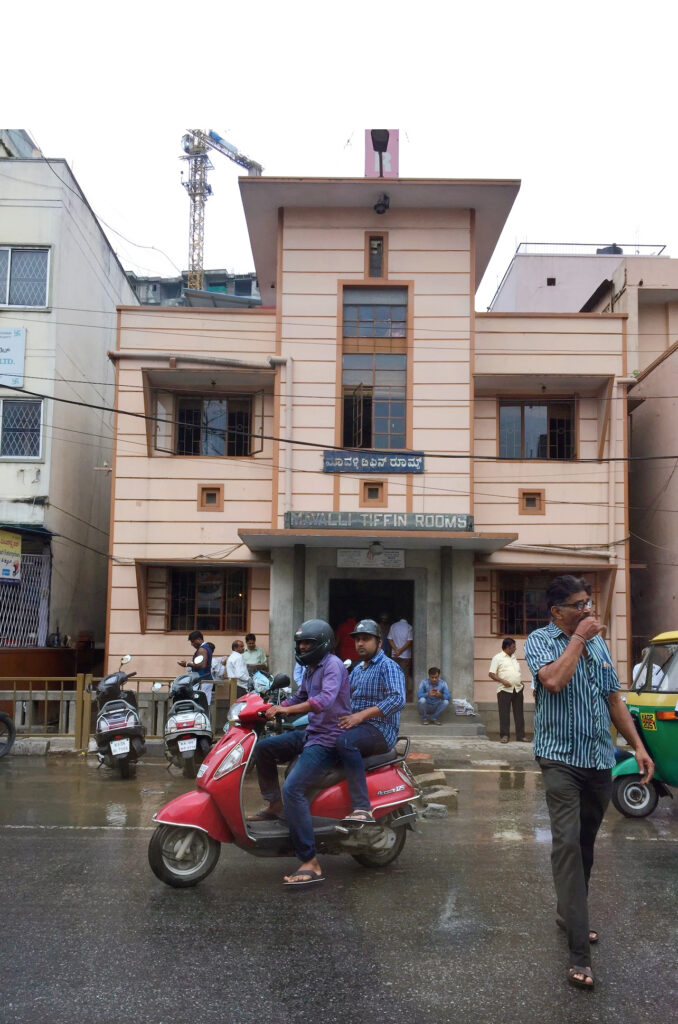
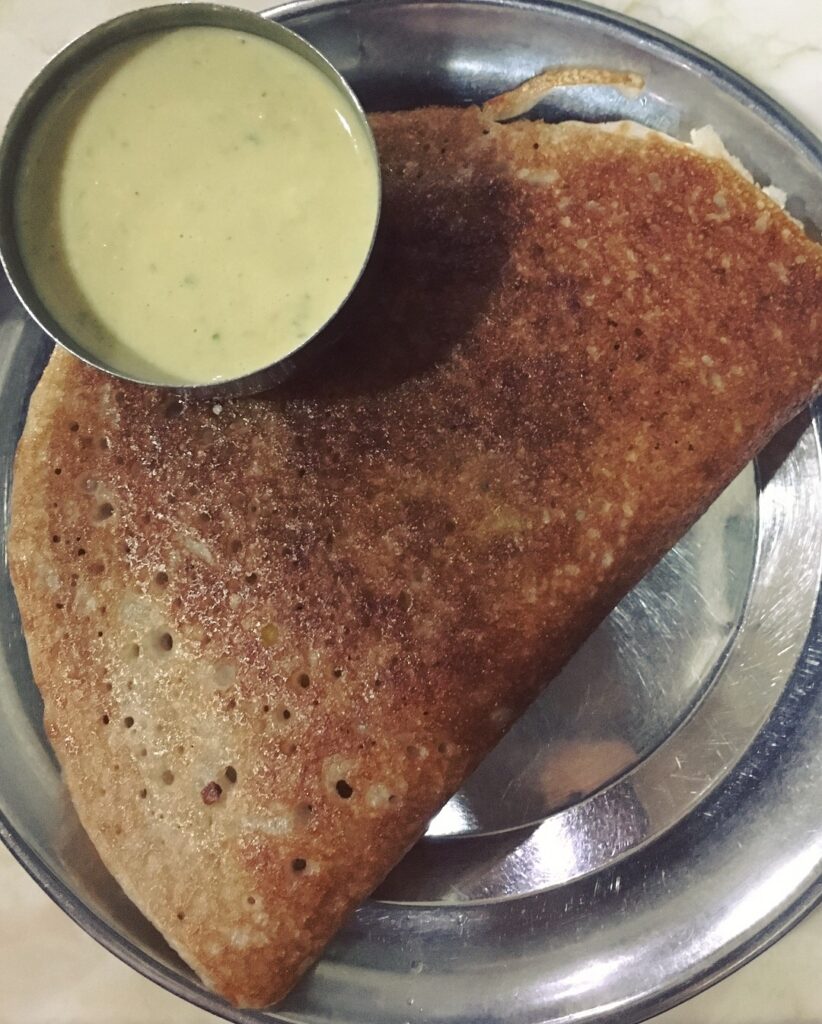
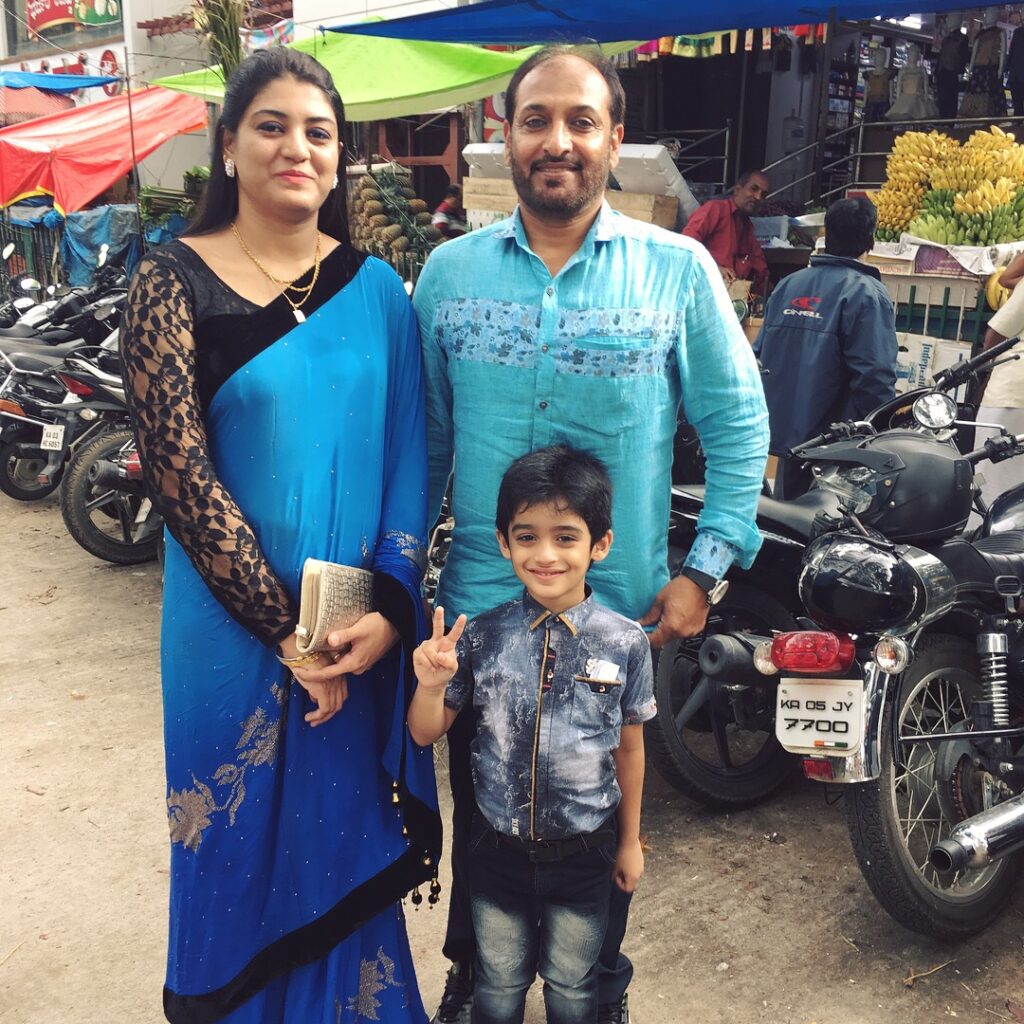
Mavalli Tiffin Rooms (MTR)
For three generations the Maiya family are hands-on and running MTR, as it is affectionately known. And now, there are also MTRs in Mysuru, Udupi, Singapore, Dubai, London, and Kuala Lumpur.
Seated opposite a family of three, the parents urged their shy son to practice his English with us. By the time we left, we’d exchanged emails and smiles all round. We enjoyed more of the city’s famous dosas plus a rice dish of lentils, vegetables, cashews, curry leaves, and tamarind called Bisi Bele Bath. Simillar to Sambar, but with a different masala, you enjoy it with raita and a big splash of ghee. Along with the filtered South Indian coffee, it all slipped down with tremendous ease. Back out on the street it was time to stroll the shops and vegetable market of Mahatma Gandhi Road.
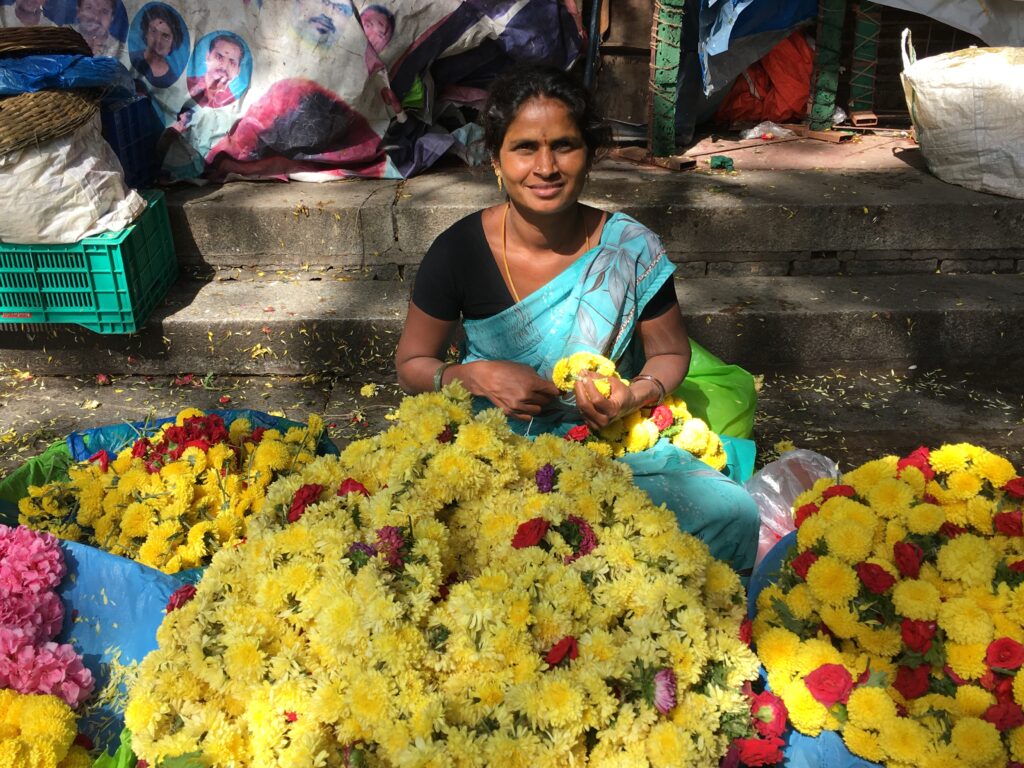
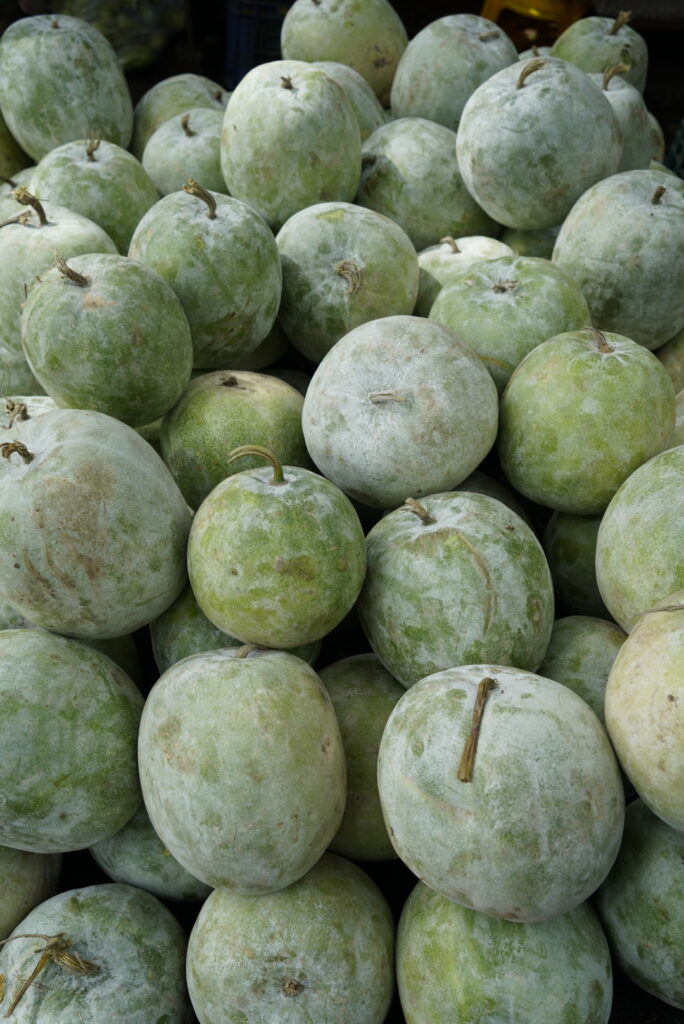
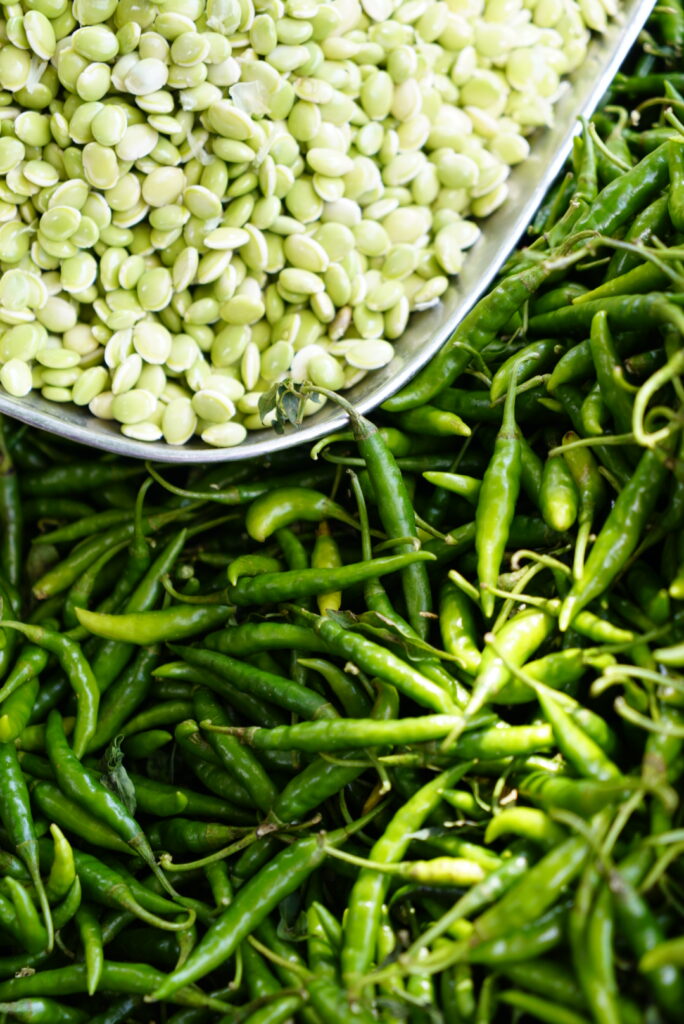
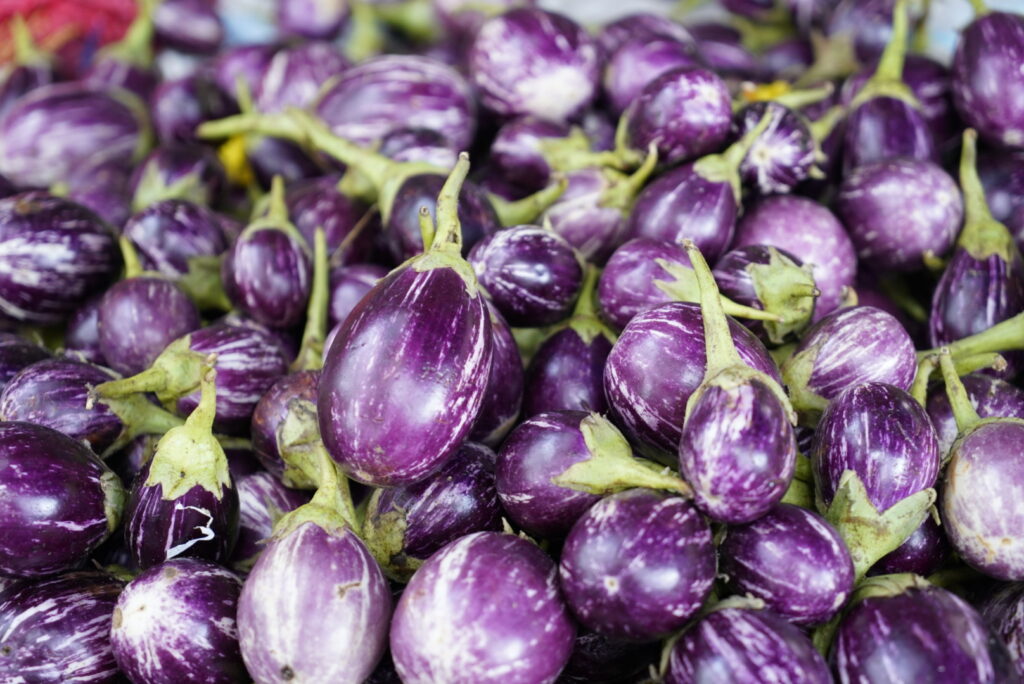
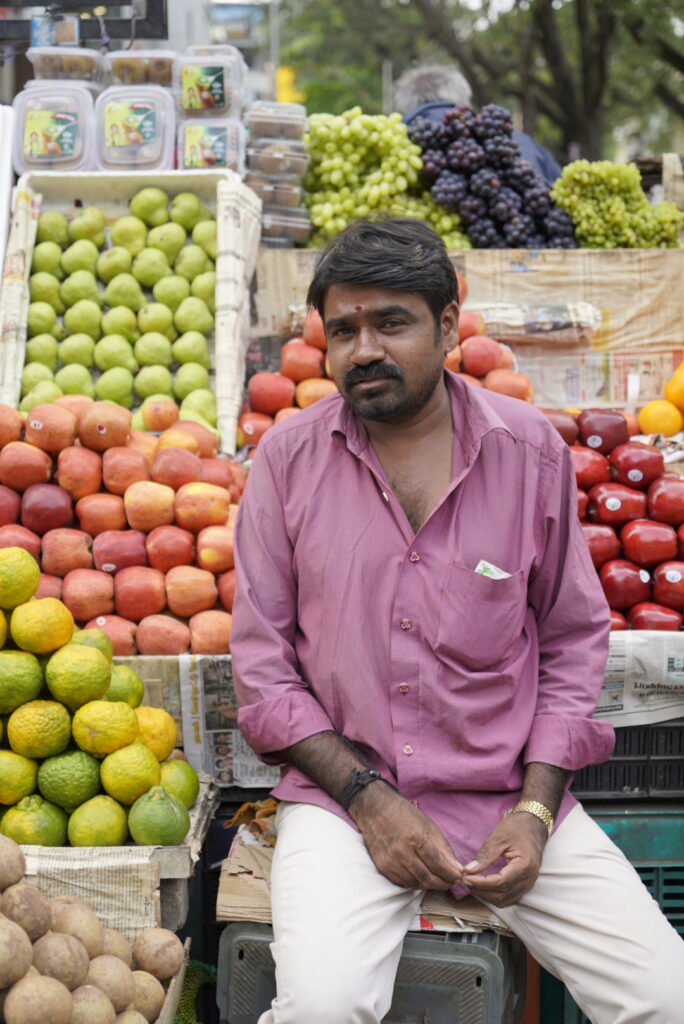
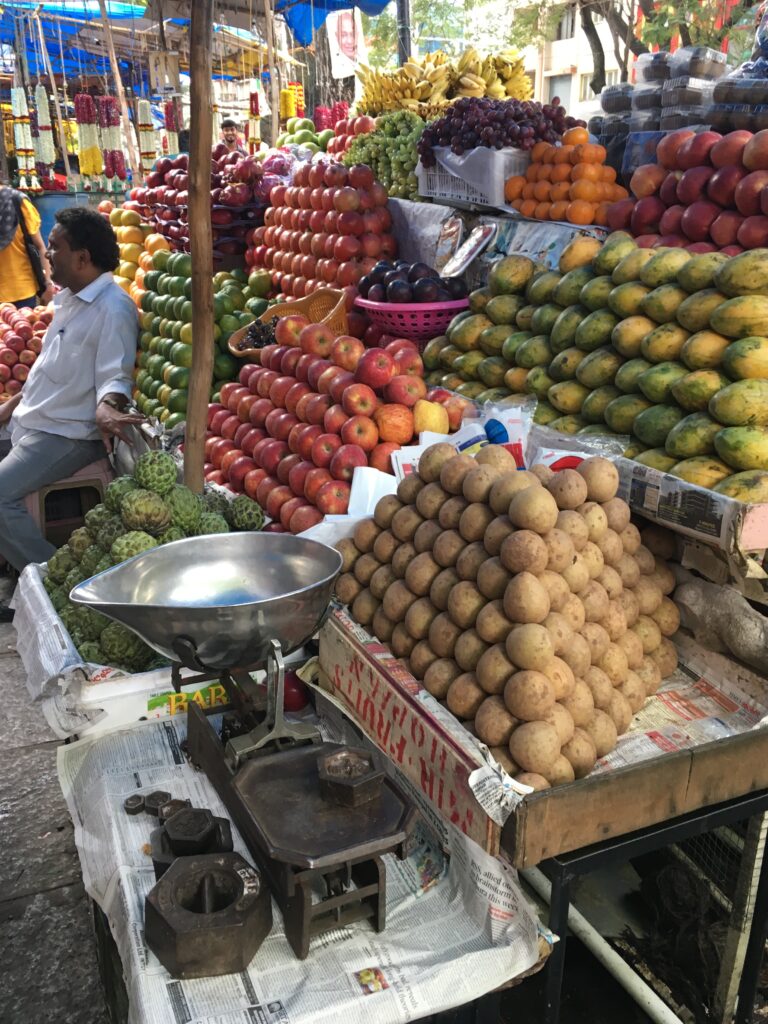
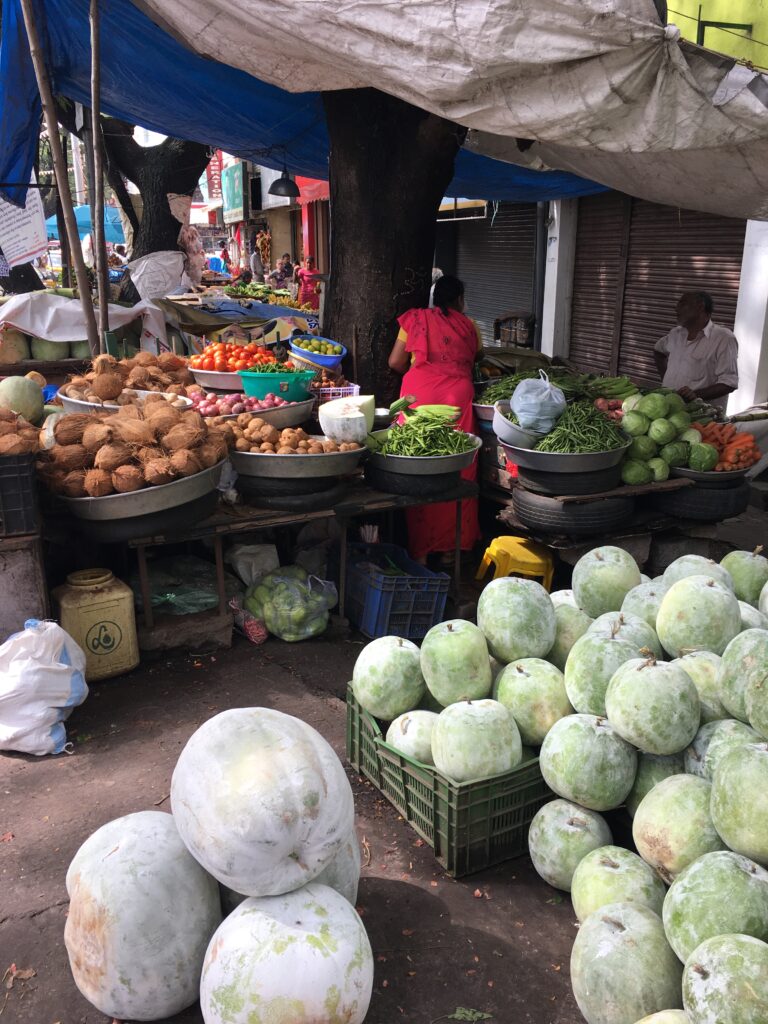
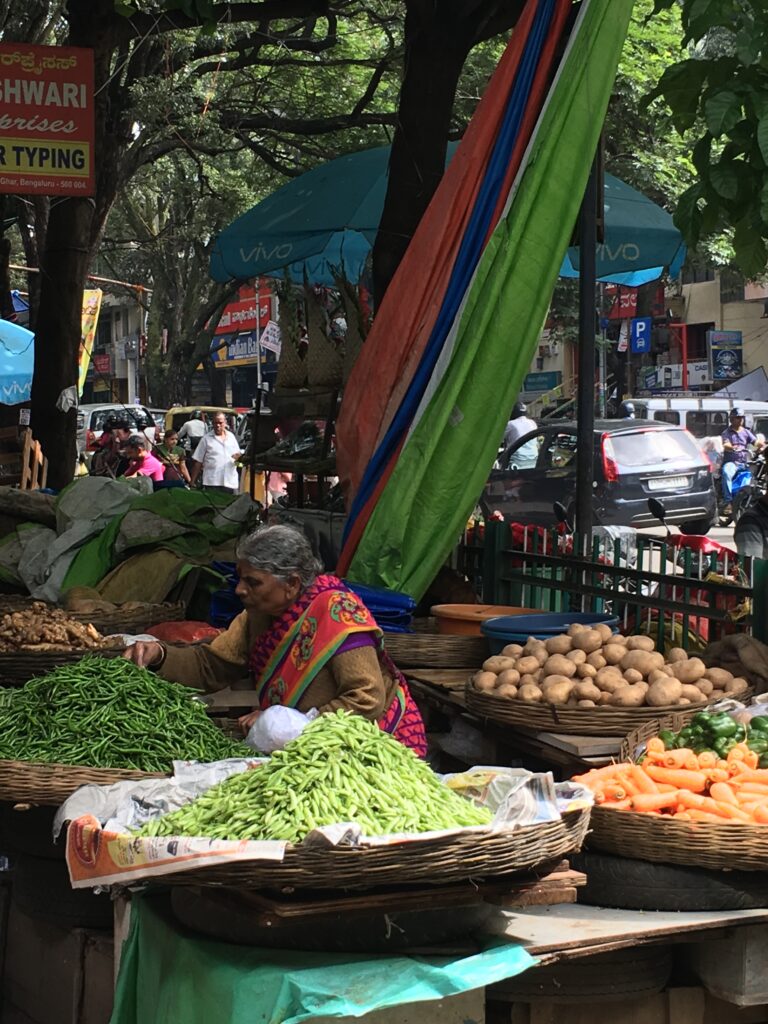
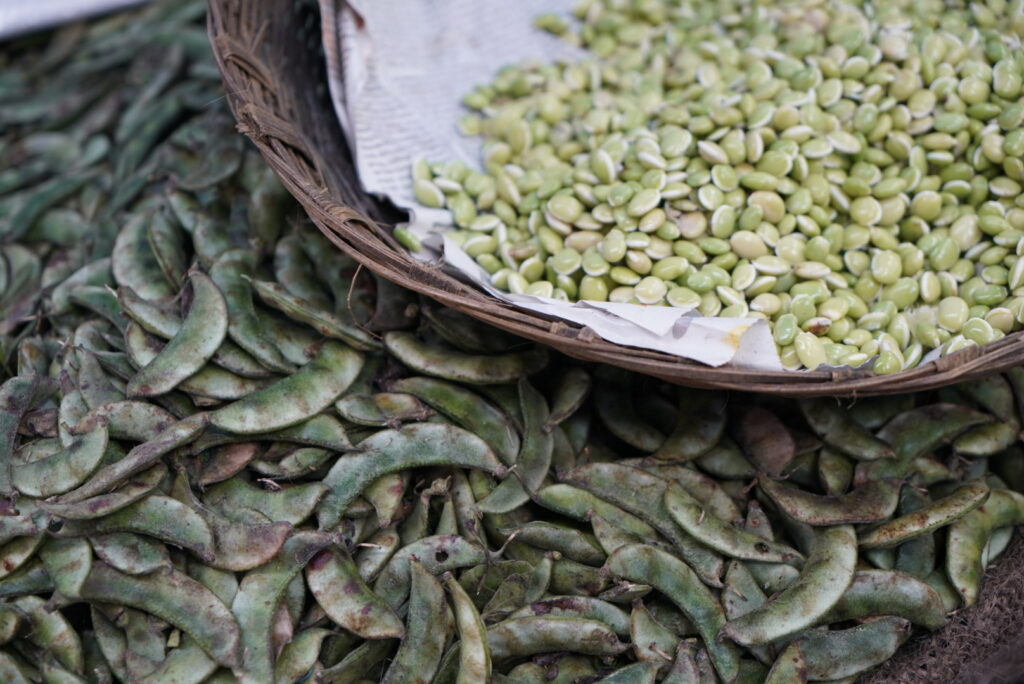
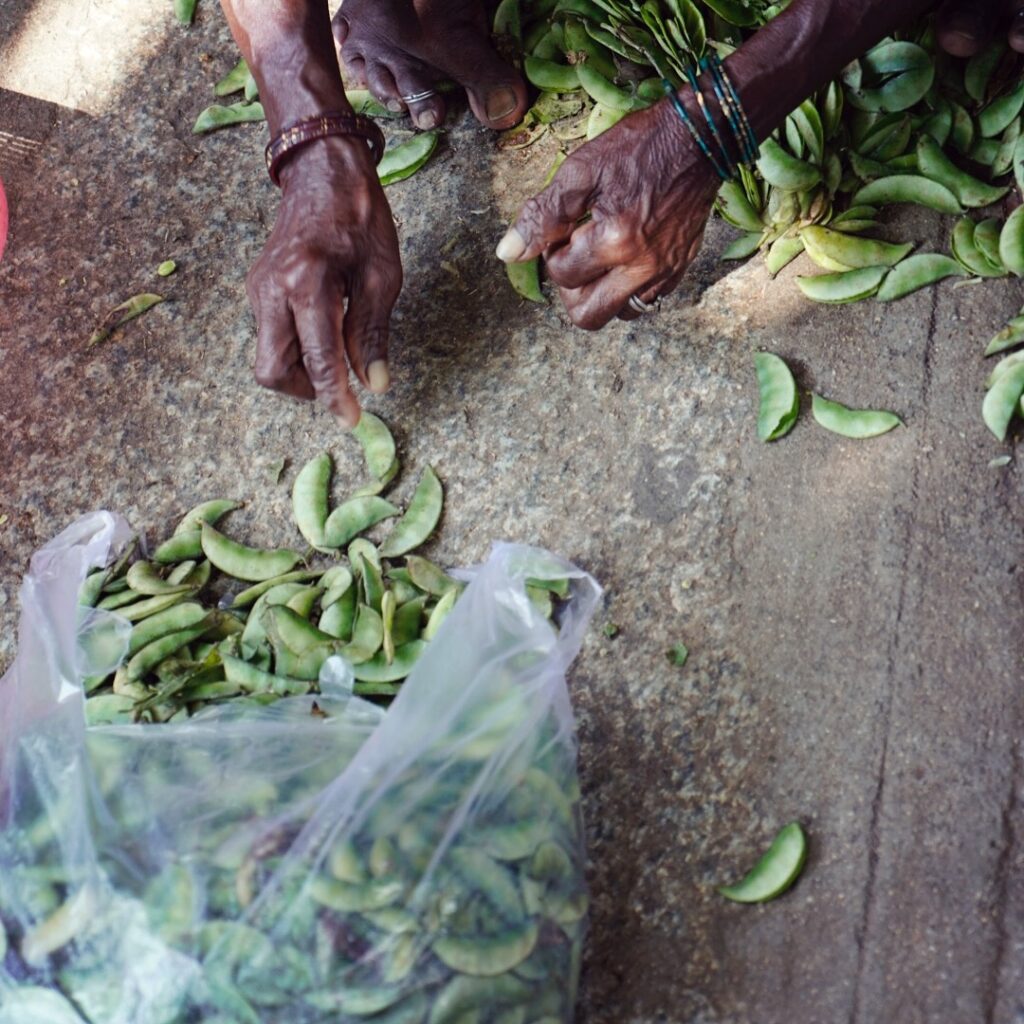
Mahatma Gandhi (MG) Road Market
MG Road’s Sunday market is full of food splendour. The quality and variety of the produce here is extensive. We saw ash gourds the size of foot stools. Vendors carefully arrange long cool bottle gourds, green papaya, and fragrant custard apples for display. Baskets overflow with limes and lemons. Grey haired, toothless women stack herbs and greens on brightly coloured blankets and tarps strewn along the sides of the sidewalks. They chat continuously with each other but always kept one eye on the foot traffic. No doubt, their retail instincts are ready in an instant for bartering with the passersby.
One stall had neat stacks of fat, long, green and yellow striped field cucumbers, chubby orange carrots, and fat, purple and white striped balls of eggplant. At another, a man sat shelling peas and beans. He left some pods intact and worked at filling bags with the peas he’d shelled himself. Saving a busy cook the trouble, he could charge a bit more for the convenience he offered. Pumpkins of every shape and size were stacked pel mel. And, of course, garlic, ginger, chilies, tomatoes, and onions are ubiquitous.
Having no stove or pots, pans, or utensils was torture when we were surrounded by the glory of this produce. To console ourselves, we made a beeline to one of the street’s most famous sweet shops.
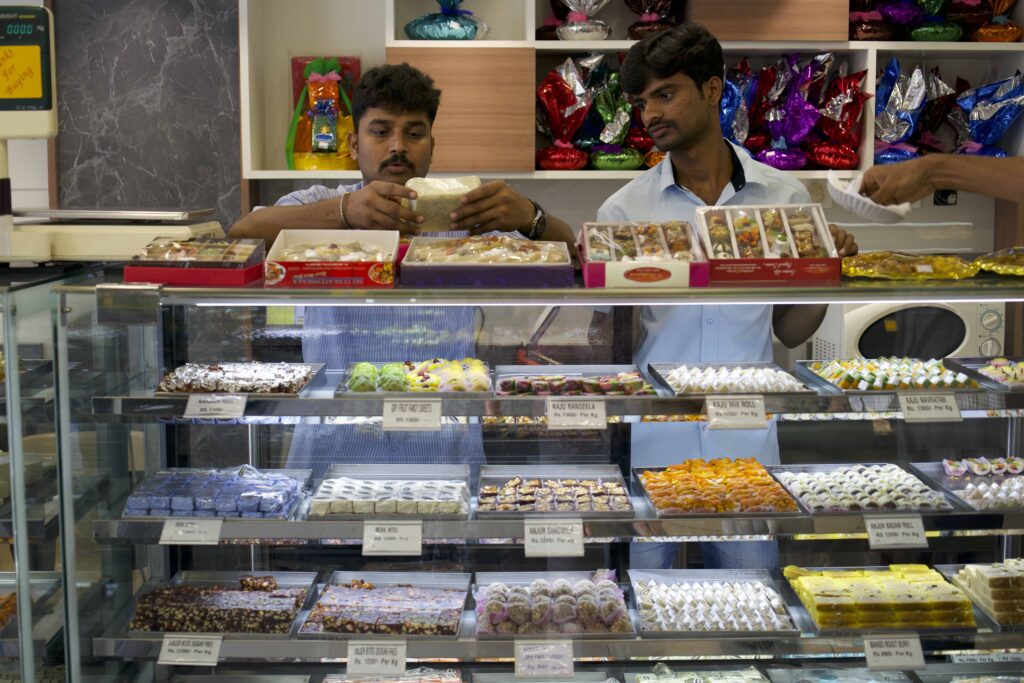
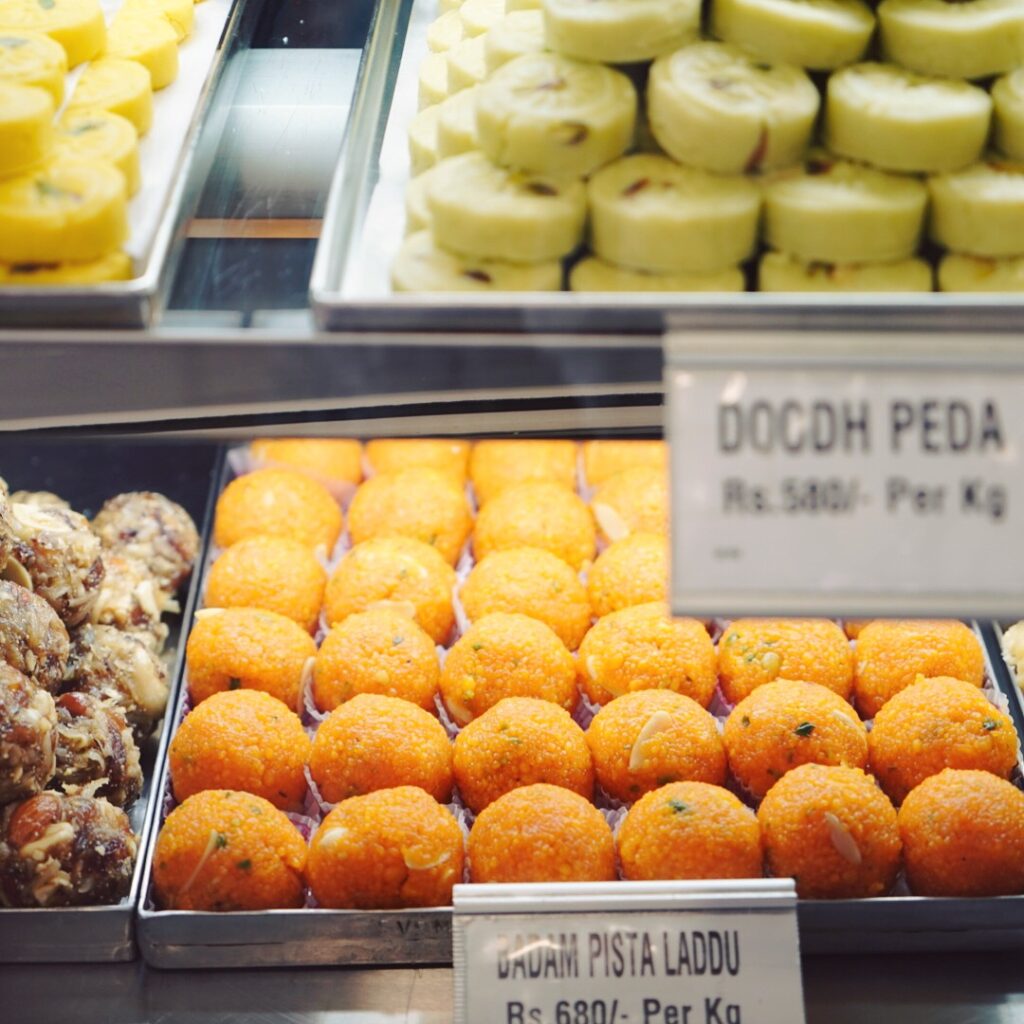
Sri Venkateshwara Sweet-Meat Stall
The choices and quality at Sri Venkateshwara are impressive. Starting with savory snacks, there are many kinds of Sev (various shapes and sizes of fried dough) plus an assortment of freshly roasted nuts. The sweets come in vibrant yellows, greens, pinks and oranges and in shapes of flowers, rolls, sandwiches, fudge, and pinwheels. Turkish Halwa in a pretty rosy pink called to us. Burfi was tempting. Date and Besan Laduus, Mawa Badam, Ajmer Cakes, and Silver-Laced Mothi Pak all tempted our palates but we knew what we came for. We left with boxes of the world’s best Mysore Pak. The creamy, flaky layers of fudgy richness are the sweet of our dreams. If you go, we hope you’ll try it. If you can’t make it to Bengaluru, please try our recipe that follows.
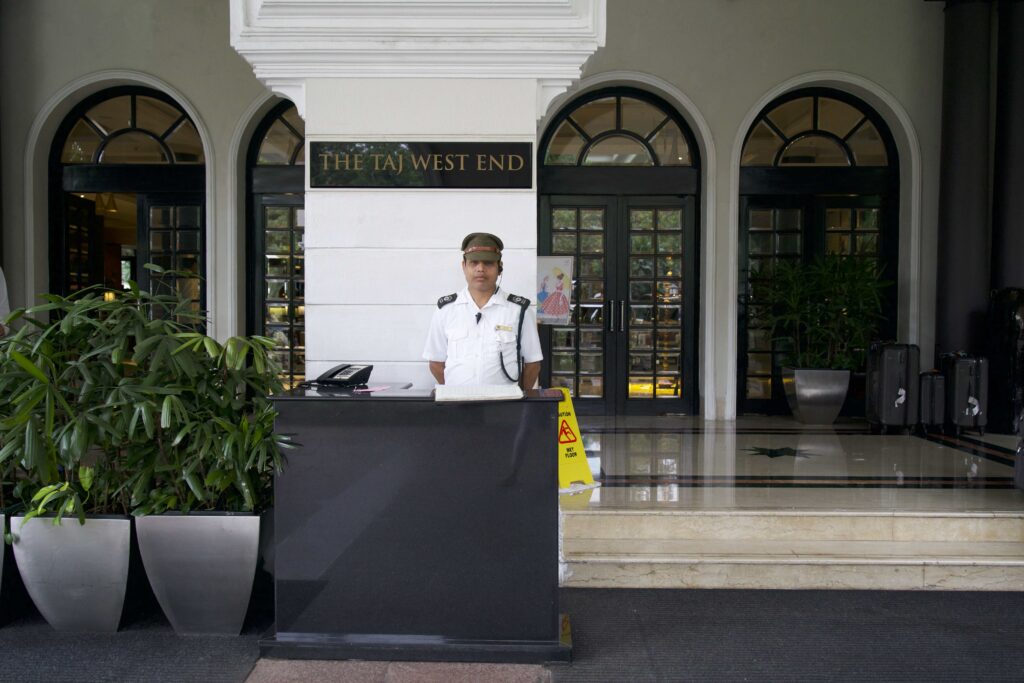
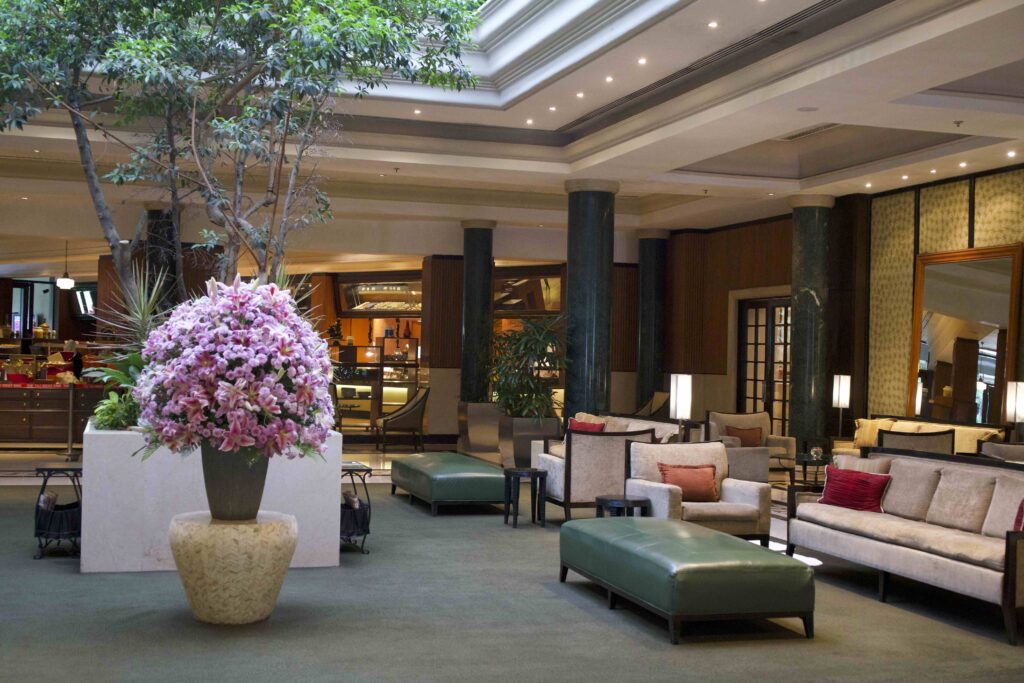
Bengaluru Travel Guide: Where we stayed
We hope you enjoyed this post and our Bengaluru Travel Guide. And, we have one more recommendation before we move on to some recipes. We stayed at the Taj West End while in Bengaluru. Its gardens, pool, and TLC are in keeping with the 5 star rating and “Tajness” the brand is so famous for. Dining is a delight here as well. Whether you enjoy a classic South Indian or international breakfast on the veranda overlooking the pool or eating sublime Vietnamese cuisine in the Blue Ginger restaurant, we hope you are as impressed as we were.
Bengaluru is many things but, being India’s silicon city, it is also very cosmopolitan. Expats and locals alike enjoy the flavours of the world here. But, they’ll always be most proud of their desi dosas and sweets.
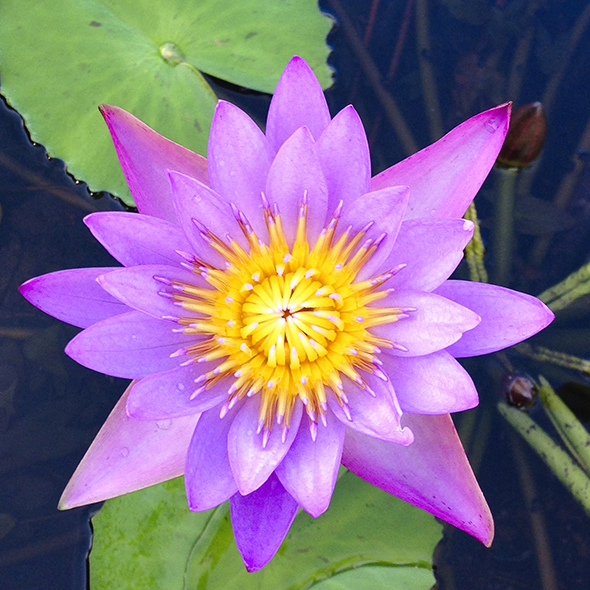
Gratitude
Thank you to Hi Tours for sponsoring our travel throughout this portion of our South India Road Trip and to the team at The Taj West End for their gracious hospitality during our Faces, Places and Plates stay in Bengaluru in 2017. Thanks also to our wonderful city guide Chendra for getting us around and being so delightful.
All words and photos are our own. We did not share with the sponsors before publication.

